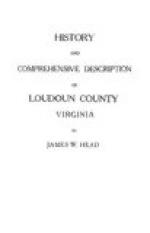* * * * *
“Along the eastern side of the valley (Loudoun) gneiss is frequently met with on the surface, and where the larger streams have worn deep valleys, it is sometimes exposed in high and precipitous cliffs. This is more particularly the case along Goose Creek and Beaver Dam. Associated with it, however, is clay slate, not so much in rock as in soil, for it being more readily decomposed is seldom found on the surface, except as soil. These two varieties are often met with side by side in thin layers, and their combination at the surface forms a peculiarly favorable soil for agricultural purposes. The gneiss from the quartz it contains makes a sandy soil, while the clay slate gives it tenacity. This happy combination is a prevailing feature of this entire valley, and renders it one of the best farming sections in Virginia.
“Another rock that is a valuable acquisition is hornblende. This kind when first taken from the ground, is always covered as with a coat of rust. This is doubtless the fact, for the oxydasion of the iron it contains gives it that appearance, and colors the soil a reddish hue in its immediate vicinity. Wherever this rock abounds, the soil is durable and the crops are usually heavy. It is sometimes met with having a fine grain, and so very hard as to be almost brittle, though generally very difficult to break, and when broken strongly resembling cast-iron, and will sometimes ring, on being struck, almost as clearly. It was used very much formerly for making journals to run mill-gudgeons upon. When found on the surface, it is usually of a rounded form....”
However, much of the rock of the valley partakes of the nature of both hornblend and gneiss, and has been aptly termed a “hornblend gneiss rock.”
Beds of magnesian or talcose slate, sometimes containing crystals of sulphuret of iron, are frequently met with in this section, and at the base of Black Oak Ridge, which is composed chiefly of chlorite slate and epidote, another bed of magnesian limestone is found. Containing about 40 per cent of magnesia, it makes an excellent cement for walls, but is of little or no value as a fertilizer.
SOILS.[10]
The soils of Loudoun vary greatly in both geological character and productiveness, every variety from a rich alluvial to an unproductive clay occurring within her boundaries. In general the soils are deep and rich and profitably cultivated.
The heavy clay soils of Loudoun are recognized as being the strongest wheat and grass soils. The more loamy soils are better for corn on account of the possibility of more thorough cultivation. However, the lands all have to be fertilized or limed to obtain the best results, and with this added expense the profit in wheat growing is extremely uncertain on any but the clay soils. The loamy soils are especially adapted to corn, stock raising, and dairying,




